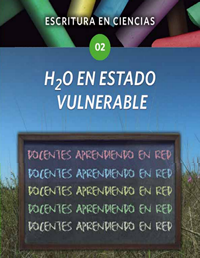 El profesor formador y los temas disciplinares
El profesor formador y los temas disciplinares
Autores: Mónica Liliana Tuntisi, Andrea Beatriz Villalba, María Valeria Pereyra, Francisco Javier Alfaro, Marcelo Mario Miguel, David Gonzalo Yampa
Equipo Escritura en Ciencias del Instituto Nacional de Formación Docente Liliana Calderón, Carmen E. Gómez y Antonio Gutiérrez
Orientación y asesoramiento científico: Miguel Angel Blesa
Coordinación de Escritura: Alicia Vázquez
Disciplina: Biología
Tema disciplinar: La contaminación del agua
Destacado: El texto disciplinar escrito por Formadores presenta aspectos que se relacionan con la contaminación del agua desde una mirada físico-química, biológica y su impacto en la salud humana, como así también los métodos actuales de remediación.
Se tratan además las implicancias que tienen sobre el tema los aspectos legales y las gestiones políticas actuales, para finalizar con el estudio de los casos más relevantes de contaminación del agua en Argentina.
H20 en estado vulnerable. Colección Escritura en Ciencias
![]() http://cedoc.infd.edu.ar/upload/2H2Ovulnerable.pdf
http://cedoc.infd.edu.ar/upload/2H2Ovulnerable.pdf
Ver Conferencia del Dr. Alzogaray. H20 en estado vulnerable. La contaminación del agua.
![]() http://audiovisuales.infd.edu.ar/sitio/index.cgi?wid_seccion=22&wid_item=48
http://audiovisuales.infd.edu.ar/sitio/index.cgi?wid_seccion=22&wid_item=48

Drift Boss solely concentrates on the skill of precisely regulating the car’s trajectory and cornering; there is no requirement for high speed or strong acceleration.
Drift Boss solely concentrates on the skill of precisely regulating the car’s trajectory and cornering; there is no requirement for high speed or strong acceleration.
This is a really interesting piece! It’s crucial for teacher training to delve into specific disciplinary subjects, like biology and, in this case, water pollution. I wonder how the training program addresses the often-complex communication of scientific concepts to students with diverse learning styles. It’s almost like trying to fit a square peg into a round hole sometimes. Getting bogged down in the scientific details without accessibility is like driving an Eggy Car through mud – you’re not going to get very far! It’d be great to hear more about practical teaching strategies that bridge that gap.
If you’ve never played Moto X3M, imagine being Evel Knievel’s cartoon alter ego who thinks gravity is optional and ramps floating mid-air are just life’s way of saying “good luck.”
This article provides a comprehensive overview of water contamination, exploring its physical, chemical, and biological aspects, as well as its impact on human health and current remediation methods. The inclusion of legal and political implications is particularly insightful. The focus on real-world cases in Argentina adds practical value. It’s a valuable resource for anyone interested in this crucial topic. For a fun creative break, I recommend checking out AI Cartoon Generator to generate some cool cartoon images!
This is a really insightful piece on water contamination, exploring its physical, chemical, and biological aspects, as well as its impact on human health and legal/political implications. The focus on remediation methods and relevant Argentine cases is particularly valuable. For those of us interested in building compelling narratives, I recommend checking out Character Headcanon Generator for creative inspiration.
This is a well-researched piece on water contamination, exploring both the scientific and socio-political dimensions of the issue. The inclusion of legal aspects and remediation methods provides a comprehensive understanding. It’s great to see the focus on the Argentinian context and the inclusion of resources like the conference and the downloadable text. For those interested in a different type of analysis, you might find it interesting to check out AI Beauty Rating.
This article on water contamination, seen through physical-chemical and biological lenses, is fascinating. I particularly appreciate the inclusion of legal and political aspects, along with case studies from Argentina. The resources provided, including the conference link, are invaluable. If you’re ever looking to organize this type of information or create a report, I highly recommend using Markdown to Word to easily convert your notes into a clean .docx format.
This article offers a comprehensive look at water contamination, exploring its physical, chemical, and biological aspects, as well as its impact on human health and remediation methods. The inclusion of legal and political implications, alongside case studies from Argentina, provides a thorough understanding of this critical issue. It’s fascinating how the authors connect these various facets. For anyone looking to visually represent complex concepts from the article, I highly recommend checking out Image to Prompt, which can generate prompts for AI image models based on your ideas.
Supermaker GOOD article,It is so useful for me3
That’s interesting! It’s always good to see resources that connect science with real-world problems like water pollution in Argentina. I wonder if there’s more information on how schools are addressing this topic in the classroom. I’ll share this with my friends!
Enter Nano banana AI built on Google’s cutting-edge AI models This free, intuitive platform empowers you to generate and edit visuals with simple text prompts, making creativity accessible to everyone.
Wow, «H20 en estado vulnerable» is a really important topic! Thinking about all the ways water can be affected – physically and chemically – is fascinating. Makes me wish I had some quick, easy way to document my research… maybe I should check out AI Video Generator for some short, high-quality videos?
VEOE AI Create stunning videos with audio using Google’s most advanced Veo 3 AI model.